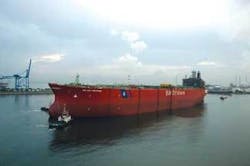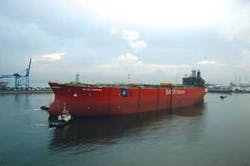Floater specialist building fleet for global expansion
Delivering the Ku-Maloob-Zaap FPSO to Pemex will be a milestone for Bergesen Worldwide Offshore. This will be the first FPSO in the Gulf of Mexico and the world’s largest production ship measured by throughput. The project also marks a significant step in BWO’s ambition of extending its FPSO operations beyond West Africa.
“We worked very hard to get the KMZ contract,” says Elisabeth Barstad, director of business development. “We’ve gone through an evolutionary process, building our expertise brick by brick. We’ve had good success on the projects we have done so far, and the customers are happy.”
The $1 billion KMZ contract, covering 15 years’ lease and operation, was awarded in July 2005. Considering the size and complexity of the conversion, the 21-month period from contract signing to first oil constitutes a fast-track project. The FPSO,BW Enterprise, is being converted from a 1980 vintage, 360,700 dwt tanker from the Bergesen Worldwide group’s fleet. The ship, 340 m long and 65 m in beam, entered Sembawang Shipyard in Singapore for conversion last December. Major topside modules were due to be lifted onboard this summer. Separation, gas compression, and fuel gas treatment facilities weigh a combined 2,000 metric tons.
Engineering of the process plant is being carried out by Kanfa Engineering, with fabrication handled by the Lamprell Energy yard in Dubai. Additional utility modules are being fabricated by GSI in Singapore and at Sembawang.
The vessel is being fitted with an internal turret located towards the bow. This will be a submerged production turret to be supplied by APL, with Framo Engineering responsible for the swivel. The turret is disconnectable, but it also enables the mooring system to be pre-installed, Barstad explains. Installation of the mooring system, which is designed to withstand hurricane conditions in the GoM, will be time-consuming, not least due to the complexity of the infrastructure in the area, where there are 20 platforms installed.
The FPSO is due to leave Singapore towards the end of the year, with first oil expected in April 2007. It will have the capacity to process 200,000 b/d of oil and 120 MMcf/d of gas. The crude will have a 13°API rating, but 400,000 b/d of stabilized 21°API crude also will be imported and blended with the oil processed on board to result in an intermediate grade. Total oil handling capacity therefore is an immense 600,000 b/d - roughly equivalent, Barstad points out, to around 15% of Mexico’s oil production.
Storage capacity will be 2.2 MMbbl, with a daily offloading capacity of 1.2 MMb/d. In case of interruptions to offloading operations, an oil export pipeline also will be installed for use as required.
BW Enterprise will make its way to Mexico under its own diesel propulsion, but once in Mexican waters, in line with Mexican regulations, it will be towed to location, close to the giant Cantarell field in the Bay of Campeche. Pemex has been involved closely in the project, and has some of its personnel working with the BWO project team in Oslo.
The KMZ project should position BWO well for future FPSO projects in this part of the world. As is well known, Pemex is advancing its operations into deeper waters, where it could well have future FPSO requirements. The US side of the GoM also could be a target market now that it has opened up for FPSOs, and so could Brazil now that BWO has widened its experience.
Asian ambition
Bergesen also is looking towards developments in southern Asia, where it sees many opportunities. It has established a joint venture with MISC - Malaysian Shipping Corp. - aiming to develop a market for gas and LPG FPSOs. The company also is acquiring experience of operations in the Arctic, another region touted as a future offshore growth area. Here it has theBelokamenka, a sistership of the BW Enterprise, working as an Arctic FSO for Rosneft in Kola Bay.
Off West Africa, the company currently has three FPSOs in service, namely theBerge Helene, on Woodside’s Chinguetti field off Mauritania; Sendje Ceiba, on Hess’ Ceiba field off Equatorial Guinea; and Sendje Berge, on Addax’s Okwori field off Nigeria.
BWO also has an LPG ship operating in Nigeria’s Bonny River, theBerge Okoloba Toru, on contract to Global E&R, an LPG distributor. The ship receives a LPG mix delivered by Shell. A splitter has been installed to enable the LPG to be processed into propane and butane.
The company has other vessels lined up for the market. The largest isBW Nisa, with a 2.2 MMbbl storage capacity; the vessel is currently working in the Far East as an FSO, but available for conversion. This year the company acquired Genie, a Suezmax tanker to be renamed BW Pioneer, for conversion, BW Endeavour, a Suezmax-size FPSO, and the 70,000 cu m LPG carrier Andean Gas, which is available for BWO’s next LPG FPSO project.

